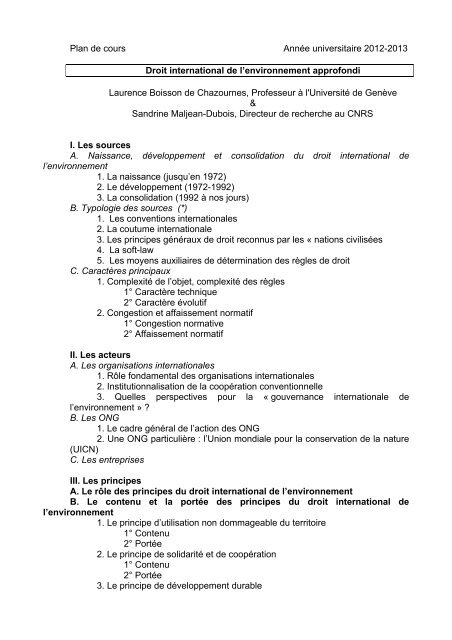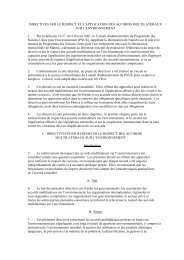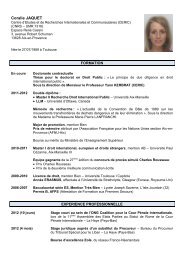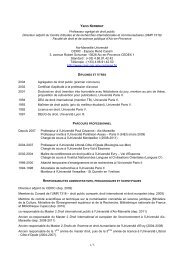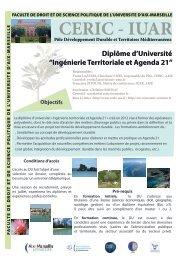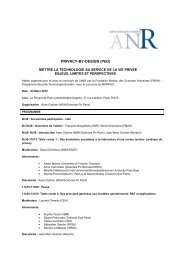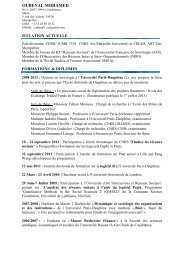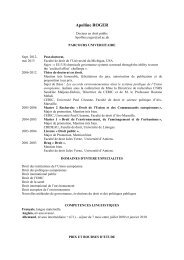Plan de cours et bibliographie - CERIC
Plan de cours et bibliographie - CERIC
Plan de cours et bibliographie - CERIC
Create successful ePaper yourself
Turn your PDF publications into a flip-book with our unique Google optimized e-Paper software.
<strong>Plan</strong> <strong>de</strong> <strong>cours</strong> Année universitaire 2012-2013Droit international <strong>de</strong> l’environnement approfondiLaurence Boisson <strong>de</strong> Chazournes, Professeur à l'Université <strong>de</strong> Genève&Sandrine Maljean-Dubois, Directeur <strong>de</strong> recherche au CNRSI. Les sourcesA. Naissance, développement <strong>et</strong> consolidation du droit international <strong>de</strong>l’environnement1. La naissance (jusqu’en 1972)2. Le développement (1972-1992)3. La consolidation (1992 à nos jours)B. Typologie <strong>de</strong>s sources (*)1. Les conventions internationales2. La coutume internationale3. Les principes généraux <strong>de</strong> droit reconnus par les « nations civilisées4. La soft-law5. Les moyens auxiliaires <strong>de</strong> détermination <strong>de</strong>s règles <strong>de</strong> droitC. Caractères principaux1. Complexité <strong>de</strong> l’obj<strong>et</strong>, complexité <strong>de</strong>s règles1° Caractère technique2° Caractère évolutif2. Congestion <strong>et</strong> affaissement normatif1° Congestion normative2° Affaissement normatifII. Les acteursA. Les organisations internationales1. Rôle fondamental <strong>de</strong>s organisations internationales2. Institutionnalisation <strong>de</strong> la coopération conventionnelle3. Quelles perspectives pour la « gouvernance internationale <strong>de</strong>l’environnement » ?B. Les ONG1. Le cadre général <strong>de</strong> l’action <strong>de</strong>s ONG2. Une ONG particulière : l’Union mondiale pour la conservation <strong>de</strong> la nature(UICN)C. Les entreprisesIII. Les principesA. Le rôle <strong>de</strong>s principes du droit international <strong>de</strong> l’environnementB. Le contenu <strong>et</strong> la portée <strong>de</strong>s principes du droit international <strong>de</strong>l’environnement1. Le principe d’utilisation non dommageable du territoire1° Contenu2° Portée2. Le principe <strong>de</strong> solidarité <strong>et</strong> <strong>de</strong> coopération1° Contenu2° Portée3. Le principe <strong>de</strong> développement durable
1° Contenu2° Portée4. Le principe <strong>de</strong>s responsabilités communes mais différenciées1° Contenu2° Portée5. Le principe <strong>de</strong> prévention <strong>de</strong>s dommages6. Le principe <strong>de</strong> précaution1° Contenu2° Portée7. Le principe du pollueur-payeur1° Contenu2° Portée8. Le principe <strong>de</strong> participation publiqueIV. La mise en œuvre du droit international <strong>de</strong> l’environnementA. Les difficultés <strong>de</strong> mise en œuvre du droit international <strong>de</strong> l’environnement1. Terminologie : efficacité, effectivité, effectiveness2. Des difficultés propres à l’ordre juridique international3. Difficultés propres au droit international <strong>de</strong> l’environnementB. La promotion <strong>de</strong> la mise en œuvre du droit international <strong>de</strong> l’environnement1. L’accompagnement : surveillance <strong>et</strong> vérification2. La réaction au manquementIII.(*) Laurence Boisson <strong>de</strong> Chazournes traitera les 22-23 novembre <strong>de</strong>s points I B) <strong>et</strong>Bibliographie indicativeOuvrages. –• Arbour (J.-M), Lavallée (S.), Droit international <strong>de</strong> l’environnement, Bruylant, Bruxelles, 2006• Beer-Gabel (J.), Labat (B.), La protection internationale <strong>de</strong> la faune <strong>et</strong> <strong>de</strong> la flore sauvages, Bruxelles, Bruylant, 1999• Beer-Gabel (J.), Lestang (V.), Les commissions <strong>de</strong> pêche <strong>et</strong> leur droit, Bruylant, Bruxelles, 2003• Beurier (J.-P.), Droit international <strong>de</strong> l’environnement, Paris, Pedone, 2010• Beyerlin (U.), Marauhn (T.), International Environmental Law, Beck C.H., 2012• Birnie (P.), Boyle (A.), Redgwell (C.), International Law and the Environment, OUP, Oxford, 2009• Bodansky (D.), Brunnée (J.), Hey (E.), The Oxford Hanbook of International Environmental Law, Oxford University Press,Oxford, 2007• Bodansky (D.), The Art and Craft of International Environmental Law, Harvard University Press, 2011• Boisson <strong>de</strong> Chazournes (L.), Desgagné (R.), Mbengue (M.M), Romano (C.), Protection internationale <strong>de</strong> l’environnement,recueil d’instruments juridiques, Paris, Pedone, 2005• Boisson <strong>de</strong> Chazournes (L.), Mehdi (R.) (dir.), Une société internationale en mutation : quels acteurs pour une nouvellegouvernance ?, Bruxelles, Bruylant, 2005• Boisson <strong>de</strong> Chazournes (L.), Leb (C.), Tignino (M.) (dir.), International Law and Freshwater : the Multiple Challenges, EdwardElgar Pub., 2012• Bowman (M.), Redgwell (C.), International Law and the Conversation of Biological Diversity, 1996, Kluwer Law international• Chasek (P.), The Global Environment in the Twenty-Firts Century, Prospects for International Cooperation, 2000, NationsUnies• Chaytor (B.) (dir.), International environmental law and policy in Africa, Kluwer Aca<strong>de</strong>mic Publishers, Dordrecht, Boston, 2003• Chemillier-Gendreau (M.), Droit international <strong>et</strong> démocratie mondiale. Les raisons d’un échec, Textuel, Paris, 2002• Commission mondiale sur l’environnement <strong>et</strong> le développement, Notre avenir à tous, Fleuve, 1988• De Sa<strong>de</strong>leer (N.), Born (C.-H.), Droit international <strong>et</strong> communautaire <strong>de</strong> la biodiversité, Dalloz, Paris, 2004• De Sa<strong>de</strong>leer (N.), Environmental Principles. From Political Slogans to Legal Rules, OUP, Oxford, 2002• Dutheil <strong>de</strong> la Rochère (J.), Le droit communautaire <strong>de</strong> l’environnement : mise en œuvre <strong>et</strong> perspectives, Paris, LaDocumentation française, 1998• Encinas <strong>de</strong> Munagorri (E.) (dir.), Expertise <strong>et</strong> gouvernance du changement climatique, LGDJ, Paris, 2009
• Faure (A.), Poll<strong>et</strong> (G.), Warin (Ph.) (dir.), La construction du sens dans les politiques publiques, Paris, L’Harmattan, 1995• Fitzmaurice (A.), « International Protection of the Environment », RCADI, vol. 293, 2002• French (D.), International law and policy of sustainable <strong>de</strong>velopment, Juris Publishing, Manchester University Press, 2005• Gillespsie (A.), International Environmental Law, Policy and Ethics, Clarendon Press, 1997• Halperin (J.-L.), Profils <strong>de</strong>s mondialisations du droit, Dalloz, Paris, 2009• Hurrel (A.), Kingsbury (B.) ed., The International Politics of the Environment, Actions, Interests and Institutions, Clarendon Press, Oxford,1992• Imperiali (C.) (dir.), L’effectivité du droit international <strong>de</strong> l’environnement. Contrôle <strong>de</strong> la mise en œuvre <strong>de</strong>s conventions internationales,Paris, Economica, 1998• Jobert (B.), Muller (P.), L’État en action, Paris, PUF, 1987• Kamto (M.), Le droit <strong>de</strong> l’environnement en Afrique, EDICEF, Vanves, 1996• Kaul (I.), Grunberd (I.), Stern (M.A.), Les biens publics à l’échelle mondiale. La coopération internationale au XXIèmesiècle, Economica, Paris, 2002• Kerbrat (Y.), Maljean-Dubois (S.), The transformation of international environmental law, Hart Pub. & Pedone, 2011• Kirchner (A.), International Marine Environmental law : Institutions, Implementation, and Innovations, Kluwer LawInternational, The Hague, Andree, 2003• Kirton (J.), Trebilcock (J.), Hard choices, soft law : voluntary standards in global tra<strong>de</strong>, environmental and social governance,Hants, Burlington, Ashgate, 2004• Kiss (A.), Shelton (D.), Gui<strong>de</strong> to International Environmental Law, Brill, 2007• Kiss (A.), Shelton (D.), International Environmental Law, Transnational Publishers, New York, 2001• Kiss (A.), Shelton (D.), Traité <strong>de</strong> droit européen <strong>de</strong> l’environnement, Frison Roche, Paris, 1995• Krämer (L.) (ed.), European Environmental Law, Ashgate/Dartmouth, Al<strong>de</strong>rshot, 2003• Krämer (L.), Casebook on EU Environmental Law, Oxford/Portland, Hart Pub., 2002• Krämer (L.), EU Environmental Law, 7 ème éd., Londres, Swe<strong>et</strong> & Maxwell, 2011• Krasner (S. D.) <strong>et</strong> al, International Regimes, Ithaca, Cornell University Press, 1983• Lang (W.), Sustainable Development and International Law, Dordrecht, Boston, Londres, 1995• Lavieille (J.-M.), Droit international <strong>de</strong> l’environnement, Ellipses, Paris, 2010• Le Prestre (Ph.), Protection <strong>de</strong> l’environnement <strong>et</strong> relations internationales. Les défis <strong>de</strong> l’écopolitique mondiale, Paris, Armand Colin,2005• Lecucq (O.), Maljean-Dubois (S.) (dir.), Le rôle du juge dans le développement du droit <strong>de</strong> l’environnement, Bruylant,Bruxelles, 2008, 384 p.• Maljean-Dubois (S.) (dir.), L’outil économique en droit international <strong>de</strong> l’environnement, Paris, La Documentation française, 2002• Maljean-Dubois (S.), L’effectivité du droit international <strong>de</strong> l’environnement, Les notes <strong>de</strong> l’IDDRI, octobre 2003, n°4• Maljean-Dubois (S.), Mehdi (R.) (dir.), Les Nations Unies <strong>et</strong> la protection <strong>de</strong> l’environnement : la promotion d’un développement durable,Paris, Pedone, 1999• Maljean-Dubois (S.), Wemaëre (M.), La diplomatie climatique : les enjeux <strong>de</strong>s négociations internationales, Pedone, Paris, 2010• Maljean-Dubois (S.), Rajamani (L.) (dir.), Implementation of International Environmental Law, Martinus Nijhoff, 2011• Mazuyer (E.) <strong>et</strong> Boisson <strong>de</strong> Chazournes (L.), Le Global Compact, Bruylant, Bruxelles, 2011• Mbengue (M.M.), Essai sur une théorie du risque en droit international public. L’anticipation du risque environnemental <strong>et</strong>sanitaire, Pedone, Paris, 2009• Naim Giesbert (E.), Les dimensions scientifiques du droit <strong>de</strong> l’environnement : contribution à l’étu<strong>de</strong> <strong>de</strong>s rapports <strong>de</strong> lascience <strong>et</strong> du droit, Bruylant, Bruxelles, 1999• Nanda (V.P.), Pring (G.), International Environmental Law and Policy for the 21st Century, Martinus Nijhoff, 2012 • Noiville (C.), Du bon gouvernement <strong>de</strong>s risques : le droit <strong>et</strong> la question du « risque acceptable », PUF, Paris, 2003• Paques (M.) (dir.), La protection <strong>de</strong> l’environnement au cœur du système juridique international <strong>et</strong> du droit interne, acteurs,valeurs <strong>et</strong> efficacité, Bruylant, Bruxelles, 2003• Prieur (M.) (ed.), Les hommes <strong>et</strong> l’environnement. Quels droits pour le XXIème siècle ?; Étu<strong>de</strong>s en l’honneur <strong>de</strong> AlexandreKiss, Frison Roche, Paris, 1998• Remond-Gouilloud (M.), Du droit <strong>de</strong> détruire: essai sur le droit <strong>de</strong> l’environnement, PUF, Paris, 1989• Rubin (S.J.), Alexan<strong>de</strong>r (D.C.) (eds), NAFTA and the Environment, La Haye/Boston/Londres, Kluwer Law International, 1996• Sand (P.), The Effectiveness of International Environmental Law. A Survey of Existing Legal Instruments, Cambridge, GrotiusPublications, 1992• Sand (P.), Transnational Environmental Law. Lessons in Global Change, Kluwer Law International, 1999• Sands (P.), Greening International Law, Earthscan, Londres, 1993• Sands (P.) <strong>et</strong> al., Principles of International Environmental Law, Cambridge University Press, 2012• Scanlon (J.), Burhenne-Guilmin (F.) (dir.), International Environmental Governance : an International Regime for ProtectedAreas, Gland, IUCN, 2004• Shelton (D.) (ed.), Commitment and Compliance. The Role of Non-binding Norms in the International Legal System, Oxford,OUP, 2000• Sheridan (M.), Lavrysen (L.) ed., Environmental Law Principles in Practice, Bruylant, Bruxelles, 2002• Smouts (M.-C.), Forêts tropicales, jungle internationale. Les revers d’une écopolitique mondiale, Presses <strong>de</strong> sc. po., Paris,2001• Société française pour le droit international, Le droit international face aux enjeux environnementaux, Actes du colloque <strong>de</strong> laSociété française pour le droit international, Aix-en-Provence, Pedone, Paris, 2010• Susskind (L.E.), Environmental Diplomacy, Oxford University Press, Oxford, 1994• Thieffry (P.), Droit <strong>de</strong> l’environnement <strong>de</strong> l’Union européenne : Eléments <strong>de</strong> droit comparé américain, chinois <strong>et</strong> indien,Bruylant, Bruxelles, 2008• Truilhé-Marengo (E.), La relation juge-expert dans les contentieux sanitaires <strong>et</strong> environnementaux, La DocumentationFrançaise, 2011• Verhoeven (J.), Sands (Ph.), Bruce (M.),The Antarctic Environment and International Law, Kluwer Law International, Pays-Bas, 2003• Wijen (F.), Zo<strong>et</strong>eman (K.), Pi<strong>et</strong>ers (J.) (dir.), A Handbook of Globalisation and Environmental Policy: National GovernmentInterventions in a Global Arena, Cheltenham, UK ; Northampton, MA : Edward Elgar, 2005• Wijen (F.), Zo<strong>et</strong>eman (K.), Pi<strong>et</strong>ers (J.) (dir.), A Handbook of Globalisation and Environmental Policy: National GovernmentInterventions in a Global Arena, Cheltenham, UK ; Northampton, MA : Edward Elgar, 2005• Yoshida (O.), The International Legal Regime for the Protection of the Stratospheric Ozone Layer, Kluwer, 2001• Young (O.), The Effectiveness of International Environmental Regimes. Causal Connections and Behavioral Mechanisms,Cambridge, MIT Press, 1999
Contributions <strong>et</strong> articles. –• Boisson <strong>de</strong> Chazournes (L.), « La mise en œuvre du droit international dans le domaine <strong>de</strong> la protection <strong>de</strong> l’environnement : enjeux <strong>et</strong>défis », RGDIP, 1995• Boisson <strong>de</strong> Chazournes (L.), « New Technologies, the Precautionary Principle, and Public Participation », in T. Murphy (ed.),New Technologies and Human Rights, Oxford University Press, 2009, pp. 161-194• Boisson <strong>de</strong> Chazournes (L.), « Precaution in International Law: Reflection on Its Composite Nature », in T. M. Ndiaye <strong>et</strong> R.Wolfrum (eds.), Law of the Sea, Environmental Law and S<strong>et</strong>tlement of Disputes – Liber Amicorum Judge Thomas A. Mensah,Nijhoff, The Hague, 2007, pp. 21-34• Corcelle (G.), « 20 ans après Stockholm : la Conférence <strong>de</strong>s Nations Unies <strong>de</strong> Rio <strong>de</strong> Janeiro sur l’environnement <strong>et</strong> le développement :point <strong>de</strong> départ ou aboutissement ? », Revue du marché commun <strong>et</strong> <strong>de</strong> l’Union européenne, 1993, n°365• Dias Varella (M.), « Le rôle <strong>de</strong>s organisations non-gouvernementales dans le développement du droit international <strong>de</strong> l’environnement »,JDI, 1/2005• Dupuy (P.M.), « Où en est le droit international <strong>de</strong> l’environnement à la fin du siècle ? », RGDIP, n°4/1997• Godard (O.), « Stratégies industrielles <strong>et</strong> conventions d’environnement : <strong>de</strong> l’univers stabilisé aux univers controversés », Environnement,Économie, INSEE métho<strong>de</strong>s, n° 39-40, p. 145• Hasenclever (A.), « Interests, Power, Knowledge: The Study of International Regimes », International Studies Review, 1996, 40• Institut <strong>de</strong> droit international, « Procédures d’adoption <strong>et</strong> <strong>de</strong> mise en œuvre <strong>de</strong>s règles en matière d’environnement », Résolution du 4septembre 1997, RBDI, n°1997/2, p. 497• Kamto (M.), « Les conventions régionales sur la conservation <strong>de</strong> la nature <strong>et</strong> <strong>de</strong>s ressources naturelles en Afrique <strong>et</strong> leur mise enœuvre », in RJE, n°4, 1991• Kamto (M.), « Les nouveaux principes du droit international <strong>de</strong> l'environnement », Revue juridique <strong>de</strong> l’environnement,1993/1, p.11• Kaul (I.), « Biens publics globaux, un concept révolutionnaire », Le Mon<strong>de</strong> Diplomatique, juin 2000• Kerbrat (Y.), Maljean-Dubois (S.), « La Cour internationale <strong>de</strong> Justice face aux enjeux <strong>de</strong> protection <strong>de</strong> l’environnement : réflexionscritiques sur l’arrêt du 20 avril 2010, Usines <strong>de</strong> pâte à papier sur le fleuve Uruguay (Argentine c. Uruguay) », Revue générale <strong>de</strong> droitinternational public, n°1, 2011, t. CXV, p. 39• Kiss (A.), « Les traités-cadre : une technique juridique caractéristique du droit international <strong>de</strong> l’environnement », AFDI, 1993• Lanfranchi (M.-P.), Maljean-Dubois (S.), « Le contrôle du juge international. Un jeu d’ombres <strong>et</strong> <strong>de</strong> lumières », in Maljean-Dubois (S.)(dir.), L’effectivité du droit européen <strong>de</strong> l’environnement. Contrôle <strong>de</strong> la mise en œuvre <strong>et</strong> sanction du non-respect, Paris, LaDocumentation française, 2000• Maljean-Dubois (S.), « Environnement, développement durable <strong>et</strong> droit international. De Rio à Johannesburg : <strong>et</strong> au-<strong>de</strong>là ? », AFDI, 2002• Maljean-Dubois (S.), « La portée <strong>de</strong>s normes du droit international <strong>de</strong> l’environnement à l’égard <strong>de</strong>s entreprises », Journal du droitinternational, n°1/2012• Noiville (C.), « Principe <strong>de</strong> précaution <strong>et</strong> Organisation mondiale du Commerce. Le cas du commerce alimentaire », Journal du DroitInternational, n°2/2000• Sands (P.), « La Cour internationale <strong>de</strong> Justice, la Cour <strong>de</strong> Justice <strong>de</strong>s Communautés Européennes, <strong>et</strong> la protection <strong>de</strong>l’environnement », in M. Prieur (ed.), Les hommes <strong>et</strong> l’environnement, En hommage à A. Kiss, Paris, Frison Roche, 1998• Wemaere (M.), Maljean-Dubois (S.), « Après Durban, quelle structuration juridique pour un nouvel accord international sur le climat ? »,Revue juridique <strong>de</strong> l’environnement, n°2/2012• Wolfrum (R.), « Means of Ensuring Compliance with and Enforcement of International Environmental Law », RCADI, 1998, t. 272Voir aussi en ligne. –• S. Maljean-Dubois, Droit <strong>de</strong> l’environnement, <strong>cours</strong> numérique UNJF (en ligne sur le bureau virtuel)• Jurisclasseur Droit <strong>de</strong> l’environnement / Droit international (en ligne sur Flora)o S. Maljean-Dubois, Le droit international <strong>de</strong> l’environnement. E-fasciculeo S. Maljean-Dubois, Sources du droit international <strong>de</strong> l’environnement, Fascicule 146-10, JurisclasseurEnvironnemento L. Boisson <strong>de</strong> Chazournes, S. Maljean-Dubois, Les principes du droit international <strong>de</strong> l’environnement, Fascicule duJuris-classeur Environnemento S. Maljean-Dubois, V. Richard, Organisations internationales, Fascicule 2020, Jurisclasseur Environnement


